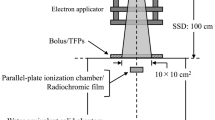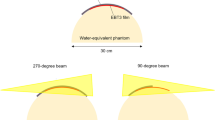Abstract
In this study, we aim to clarify the dosimetric characteristics of a real time variable shape rubber containing tungsten (STR) as a thin bolus in 6-MV photon radiotherapy. The percentage depth doses (PDDs) and lateral dose profiles (irradiation field = 10 × 10 cm2) in the water-equivalent phantom were measured and compared between no bolus, a commercial 5-mm gel bolus, and 0.5-, 1-, 2-, and 3-mm STR boluses. The characteristics of the PDDs were evaluated according to relative doses at 1 mm depth (D1mm) and depth of maximum dose (dmax). To determine the distance of the shift caused by the STR bolus, the PDD value at a depth of 100 mm without a bolus was obtained. For each STR thickness, the difference between the depth corresponding to this PDD value and 100 mm was calculated. The penumbra size and width of the 50% dose were evaluated using lateral dose profiles. The D1mm with no bolus, 5-mm gel bolus, and 0.5-, 1-, 2-, and 3-mm STR boluses were 47.6%, 91.5%, 78.2%, 86.6%, 89.3%, and 89.4%, respectively, and the respective dmax values were 15, 10, 13, 12, 11, and 10 mm. The shifting distance of the 0.5-, 1-, 2-, and 3-mm STR boluses were 2.7, 4.4, 4.8, and 4.9 mm, respectively. There were no differences for those in lateral dose profiles. The 1-mm-thick STR thin bolus shifted the depth dose profile by 4.4 mm and could be used as a customized bolus for photon radiotherapy.





Similar content being viewed by others
Data availability
The data that support the findings of this study are available from the corresponding author upon reasonable request.
References
Mahdavi JM, Petersen TH, Sjölin M, Behrens CF, Mahmood F (2015) PO-0838: Determination of the effect on patient surface dose from unwanted air cavities under bolus in VMAT. Radiother Oncol 115:S424. https://doi.org/10.1016/S0167-8140(15)40830-8
Boman E, Ojala J, Rossi M, Kapanen M (2018) Monte Carlo investigation on the effect of air gap under bolus in post-mastectomy radiotherapy. Phys Med 55:82–87. https://doi.org/10.1016/j.ejmp.2018.10.023
Ashburner MJ, Tudor S (2014) The optimization of superficial planning target volumes (PTVs) with helical tomotherapy. J Appl Clin Med Phys 15:4–12. https://doi.org/10.1120/jacmp.v15i6.4560
Khan FM, Gibbons JP (2014) Khan’s the physics of radiation therapy, 5th edn. Lippincott Williams & Wilkins, Baltimore
Aoyama T, Uto K, Shimizu H, Ebara M, Kitagawa T, Tachibana H, Suzuki K, Kodaira T (2020) Physical and dosimetric characterization of thermoset shape memory bolus developed for radiotherapy. Med Phys 47:6103–6112. https://doi.org/10.1002/mp.14516
Luu A, Doerwald-Munoz L, Ostapiak O (2015) An evaluation of two approaches to skin bolus design for patients receiving radiotherapy for head and neck cancers. J Med Imaging Radiat Sci 46:S37–S42. https://doi.org/10.1016/j.jmir.2014.08.001
Ciesielski B, Reinstein LE, Wielopolski L, Meek A (1989) Dose enhancement in buildup region by lead, aluminum, and lucite absorbers for 15 MVp photon beam. Med Phys 16:609–613
Ehler ED, Sterling DA (2020) 3D printed copper-plastic composite material for use as a radiotherapy bolus. Phys Med 76:202–206. https://doi.org/10.1016/j.ejmp.2020.07.008
Park JM, Son J, An HJ, Kim JH, Wu HG, Kim JI (2019) Bio-compatible patient-specific elastic bolus for clinical implementation. Phys Med Biol 64:105006. https://doi.org/10.1088/1361-6560/ab1c93
Al-sudani TA, Biasi G, Wilkinson D, Davis JA, Kearnan R, Matar FS, Cutajar DL, Metcalfe P, Rosenfeld AB (2020) eXaSkin: A novel high-density bolus for 6 MV X-rays radiotherapy. Phys Med 80:42–46. https://doi.org/10.1016/j.ejmp.2020.09.002
Richmond ND, Daniel JM, Whitbourn JR, Greenhalgh AD (2016) Dosimetric characteristics of brass mesh as bolus under megavoltage photon irradiation. Br J Radiol 89:20150796. https://doi.org/10.1259/bjr.20150796
Al-Rahbi ZS, Cutajar DL, Metcalfe P, Rosenfeld AB (2018) Dosimetric effects of brass mesh bolus on skin dose and dose at depth for postmastectomy chest wall irradiation. Phys Med 54:84–93. https://doi.org/10.1016/j.ejmp.2018.09.009
Kijima K, Monzen H, Matsumoto K, Tamura M, Nishimura Y (2018) The shielding ability of novel tungsten rubber against the electron beam for clinical use in radiation therapy. Anticancer Res 38:3919–3927
Kijima K, Krisanachinda A, Tamura M, Nishimura Y, Monzen H (2019) Feasibility of a tungsten rubber grid collimator for electron grid therapy. Anticancer Res 39:2799–2804
Kijima K, Krisanachinda A, Tamura M, Monzen H, Nishimura Y (2020) Reduction of occupational exposure using a novel tungsten-containing rubber shield in interventional radiology. Health Phys 118:609–614. https://doi.org/10.1097/HP.0000000000001177
Tamura M, Monzen H, Kubo K, Hirata M, Nishimura Y (2017) Feasibility of tungsten functional paper in electron grid therapy: a Monte Carlo study. Phys Med Biol 62:878–889. https://doi.org/10.1088/1361-6560/62/3/878
Takei Y, Kamomae T, Monzen H, Nakaya T, Sugita K, Suzuki K, Oguchi H, Tamura M, Nishimura Y (2020) Feasibility of using tungsten functional paper as a thin bolus for electron beam radiotherapy. Phys Eng Sci Med 43:1101–1111. https://doi.org/10.1007/s13246-020-00910-2
Kamomae T, Monzen H, Kawamura M, Okudaira K, Nakaya T, Mukoyama T, Miyake Y, Ishihara Y, Itoh Y, Naganawa S (2017) Dosimetric feasibility of using tungsten-based functional paper for flexible chest wall protectors in intraoperative electron radiotherapy for breast cancer. Phys Med Biol 63:015006. https://doi.org/10.1088/1361-6560/aa96cf
Inada M, Monzen H, Matsumoto K, Tamura M, Minami T, Nakamatsu K, Nishimura Y (2018) A novel radiation-shielding undergarment using tungsten functional paper for patients with permanent prostate brachytherapy. J Radiat Res 59:333–337. https://doi.org/10.1093/jrr/rry030
Kawai Y, Tamura M, Amano M, Kamomae T, Monzen H (2019) Dosimetric characterization of a novel surface collimator with tungsten functional paper for electron therapy. Anticancer Res 39:2839–2843
Monzen H, Kanno I, Fujimoto T, Hiraoka M (2017) Estimation of the shielding ability of a tungsten functional paper for diagnostic x-rays and gamma rays. J Appl Clin Med Phys 18:325–329. https://doi.org/10.1002/acm2.12122
Monzen H, Tamura M, Kijima K, Otsuka M, Matsumoto K, Wakabayashi K, Choi MG, Yoon DK, Doi H, Akiyama H, Nishimura Y (2019) Estimation of radiation shielding ability in electron therapy and brachytherapy with real time variable shape tungsten rubber. Phys Med 66:29–35. https://doi.org/10.1016/j.ejmp.2019.09.233
Matsumoto K, Tamura M, Otsuka M, Wakabayashi K, Kijima K, Monzen H (2020) Dosimetric characteristics of a real time shapeable tungsten containing rubber with electron beams. Nihon Hoshasen Gijutsu Gakkai Zasshi 76:1248–1255. https://doi.org/10.6009/jjrt.2020_JSRT_76.12.1248
Wakabayashi K, Monzen H, Tamura M, Matsumoto K, Takei Y, Nishimura Y (2021) Dosimetric evaluation of skin collimation with tungsten rubber for electron radiotherapy: a Monte Carlo study. J Appl Clin Med Phys 22:63–70. https://doi.org/10.1002/acm2.13210
Kawai Y, Tamura M, Amano M, Kosugi T, Monzen H (2021) First clinical experience of tungsten rubber electron adaptive therapy with real-time variable-shape tungsten rubber. Anticancer Res 41:919–925
Japanese Industrial Standards (2012) Rubber, vulcanized or thermoplastic -Determination of hardness - Part 3: Durometer method. Japanese Standards Association, Tokyo
Japanese Industrial Standards (2017) Rubber, vulcanized or thermoplastic - Determination of tensile stress-strain properties. Japanese Standards Association, Tokyo
Kamomae T, Oita M, Hayashi N, Sasaki M, Aoyama H, Oguchi H, Kawamura M, Monzen H, Itoh Y, Naganawa S (2016) Characterization of stochastic noise and post-irradiation density growth for reflective-type radiochromic film in therapeutic photon beam dosimetry. Phys Med 32:1314–1320. https://doi.org/10.1016/j.ejmp.2016.07.091
International Electrotechnical Commission (2007) IEC 60976 International Standard: Medical electrical equipment–medical electron accelerators–functional performance characteristics, Edition 2.0. IEC, Geneva
Kaushik S, Punia R, Tyagi A, Malik A (2019) Effect of scattering and differential attenuation on beam profile in the presence of high-density intensity modifying compensator. J Cancer Res Ther 15:110. https://doi.org/10.4103/jcrt.JCRT_661_17
Ordonez-Sanz C, Bowles S, Hirst A, MacDougall ND (2014) A single plan solution to chest wall radiotherapy with bolus? Br J Radiol 87:20140035. https://doi.org/10.1259/bjr.20140035
Acknowledgements
We thank Mr. Masafumi Shigita and Mr. Yoshito Kadowaki for their support. We also thank Richard Lipkin, PhD, from Edanz Group (https://en-author-services.edanz.com/ac) for editing a draft of this manuscript.
Funding
This work was supported partly by Japan Society for the Promotion of Science (JSPS) KAKENHI [grant numbers 19K08211, 19K17213].
Author information
Authors and Affiliations
Contributions
KO, HM, and MT designed the study and the analysis. KO performed the measurement and analysis the data. KO, HM, and MT performed interpretation the data. KO, HM, MT, and YN prepared manuscript. All authors collaborated on writing the manuscript, read and approved the final manuscript.
Corresponding author
Ethics declarations
Conflict of interest
Hajime Monzen received a research donation from Hayakawa Rubber Co., Ltd.
Ethical approval
This article does not involve any studies with human participants or animals performed by any of the authors.
Informed consent
This article does not involve patient data.
Additional information
Publisher's Note
Springer Nature remains neutral with regard to jurisdictional claims in published maps and institutional affiliations.
Rights and permissions
About this article
Cite this article
Okuhata, K., Tamura, M., Monzen, H. et al. Dosimetric characteristics of a thin bolus made of variable shape tungsten rubber for photon radiotherapy. Phys Eng Sci Med 44, 1249–1255 (2021). https://doi.org/10.1007/s13246-021-01059-2
Received:
Accepted:
Published:
Issue Date:
DOI: https://doi.org/10.1007/s13246-021-01059-2




